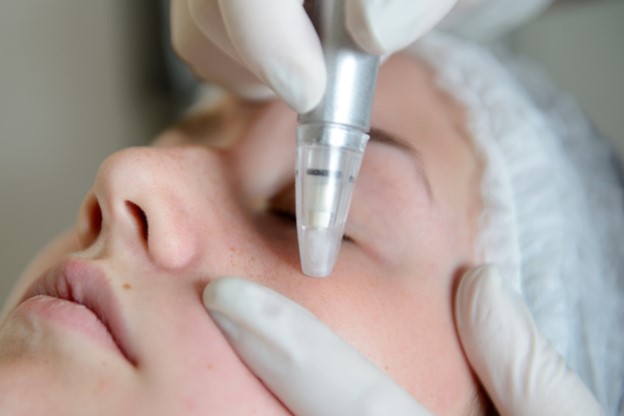In the quest for youthful, radiant skin, two popular treatments often stand out: microdermabrasion and chemical peels. Whether you’re fighting fine lines, dry patches, or dull tone, both alternatives pack a punch against common skin gripes. But how do you choose between these two rejuvenating procedures? Forget trial and error – this in-depth guide reveals the nitty-gritty of microdermabrasion and chemical peels, giving you the confidence to make an informed decision about your skincare routine.
Understanding Exfoliation: The Foundation of Skin Renewal
Exfoliation is the cornerstone of both microdermabrasion and chemical peels. Skin renewal happens when we slough off dead cells from the outer layer, called the epidermis. It’s like a minor miracle: these treatments gently strip away the dullness, leaving behind a refreshed, rejuvenated complexion that looks brand new.
The Science Behind Skin Cell Turnover
Our skin naturally sheds dead cells and replaces them with new ones. With each passing year, our skin’s cells turn over at a slower rate, allowing dead skin to accumulate and weigh us down. This accumulation can result in:
- Dull, lackluster complexion
- Rough skin texture
- Clogged pores and acne breakouts
- More visible fine lines and wrinkles
Both microdermabrasion and chemical peels accelerate this natural exfoliation process, but they do so through different mechanisms.
Physical vs. Chemical Exfoliation
Physical Exfoliation:
This method uses abrasive materials or tools to manually remove dead skin cells. Microdermabrasion falls into this category.
Chemical Exfoliation:
This approach utilizes specific chemicals to dissolve the bonds between dead skin cells, allowing them to slough off. Chemical peels take center stage in this treatment method.
Figuring out what makes your skin tick is the first step in finding a treatment that really works for you.
The Microdermabrasion Process
During a microdermabrasion treatment, a specialized device is used to gently exfoliate the skin’s surface. This process typically involves two methods:
- Crystal Microdermabrasion: Tiny crystals are sprayed onto the skin and then vacuumed away, along with dead skin cells.
- Diamond-Tip Microdermabrasion: A wand with a diamond-encrusted tip is moved across the skin, simultaneously exfoliating and suctioning away debris.
With a simple gentle lift, dead skin cells are whisked away, exposing a fresher, more youthful complexion that’s ready to take on the day.
By exfoliating the outermost layer of your skin, microdermabrasion uncovers a brighter, more refined you. Expect diminished acne scars, a gentle softness, and a rejuvenated appearance that feels just as amazing as it looks.
Improving your skin’s appearance is just a treatment away, thanks to microdermabrasion’s extensive benefits.
- Improved skin texture and tone
- Reduction in the appearance of fine lines and shallow wrinkles
- Minimized appearance of enlarged pores
- Helps clear mild acne and blackheads
- Evens out skin discoloration and sun damage
- Enhances product absorption by removing the barrier of dead skin cells
Ideal Candidates for Microdermabrasion
This treatment is generally suitable for individuals with:
- Mild to moderate skin concerns
- All skin types, including sensitive skin
- Desire for a gentle, non-invasive treatment
- Limited time for recovery
However, it may not be the best option for those with deep wrinkles, severe acne, or extensive sun damage.
The Microdermabrasion Experience
A typical microdermabrasion session lasts about 30 to 60 minutes. Patients often describe the sensation as similar to a gentle scratching or mild suction on the skin. There’s usually no pain involved, making it a comfortable experience for most.
Recovery and Results
One of the main advantages of microdermabrasion is its minimal downtime. Most people can return to their normal activities immediately after treatment. Some temporary redness or mild swelling may occur, but these effects typically subside within a few hours.
For optimal results, a series of treatments is often recommended. Many practitioners suggest 5 to 12 sessions, spaced 2 to 3 weeks apart, to achieve noticeable improvements in skin texture and appearance.
Chemical Peels: Customizable Treatments for Dramatic Results
When you need a serious skincare boost, chemical peels step in to resurface and revitalize your skin, powering away damaged layers to reveal a brighter, smoother you.
The Chemical Peel Process
During a chemical peel treatment, a solution is applied to the skin, which causes it to exfoliate and eventually peel off. The depth of the peel can be adjusted based on the specific formulation used and the duration of application.
Types of Chemical Peels
Chemical peels are typically categorized into three levels:
- Superficial Peels: These use mild acids like alpha-hydroxy acids (AHAs) to gently exfoliate the outermost layer of skin.
- Medium Peels: Utilizing stronger acids such as trichloroacetic acid (TCA), these peels penetrate deeper into the skin.
- Deep Peels: The most intensive option, deep peels use phenol to reach the lower dermal layers. These are rarely used due to potential risks and extended recovery time.
Benefits of Chemical Peels
Chemical peels can tackle a multitude of skin issues head-on, going beyond just removing dead skin cells.
- Reduction in fine lines and wrinkles
- Improvement in skin tone and texture
- Treatment of acne and acne scars
- Diminishing age spots and hyperpigmentation
- Stimulation of collagen production
- Enhanced overall skin radiance
Ideal Candidates for Chemical Peels
Chemical peels can be beneficial for individuals with:
- Moderate to severe skin concerns
- Desire for more dramatic results
- Willingness to undergo a more intensive treatment
- Ability to commit to proper post-treatment care
However, those with certain skin conditions or a history of keloid scarring may not be suitable candidates.
Comparing Microdermabrasion and Chemical Peels
While both treatments aim to improve skin appearance, they differ in several key aspects:
Treatment Intensity
- Microdermabrasion: Generally milder, with minimal discomfort and downtime.
- Chemical Peels: Can range from mild to intense, with varying levels of discomfort and recovery time.
Depth of Treatment
- Microdermabrasion: Targets only the outermost layer of skin.
- Chemical Peels: Can penetrate deeper layers, depending on the type of peel used.
Customization
- Microdermabrasion: Limited customization options.
- Chemical Peels: Highly customizable, with various formulations for different skin concerns.
Number of Treatments
- Microdermabrasion: Often requires multiple sessions for optimal results.
- Chemical Peels: Depending on the depth, may achieve significant results in fewer treatments.
Skin Concerns Addressed
- Microdermabrasion: Best for mild skin issues and general skin rejuvenation.
- Chemical Peels: Can address more severe skin concerns, including deeper wrinkles and more pronounced pigmentation issues.
Making Your Decision
Choosing between microdermabrasion and chemical peels ultimately depends on your individual skin needs, lifestyle, and desired outcomes. If you’re fed up with skin issues holding you back, take heart: these two options can help regain a radiant, vibrant you. To sift through the numerous skincare choices, start by comparing their benefits and potential drawbacks side by side, keeping your own goals top of mind.
Nobody wants to go through treatment alone; working with a qualified practitioner and taking the time to prepare and recover properly can make all the difference in your outcome. Whether you opt for the gentle exfoliation of microdermabrasion or the more intensive approach of chemical peels, committing to a comprehensive skincare routine will help you maintain your results and achieve long-lasting, radiant skin.

